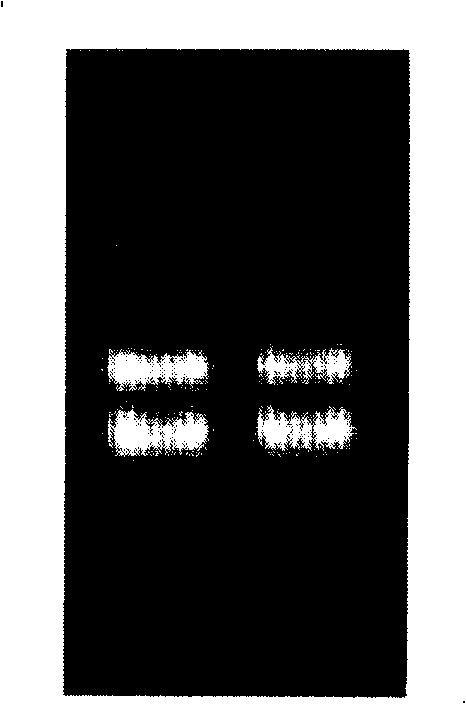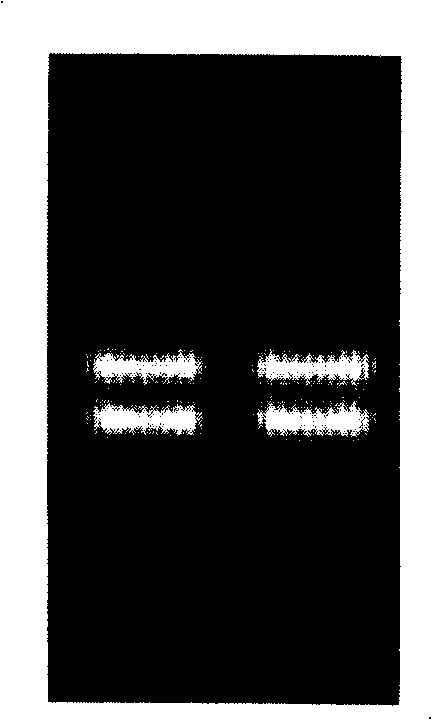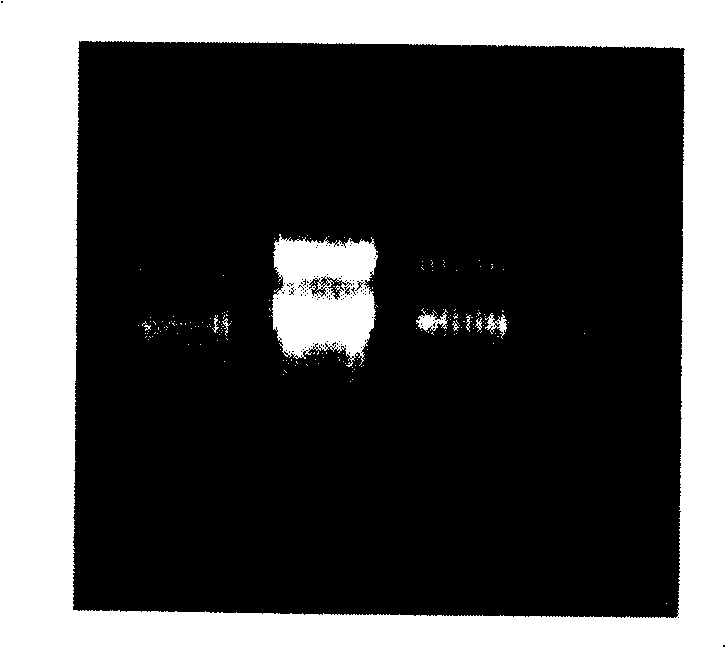Method for extracting RNA in gymnosperm tissue
A gymnosperm and tissue technology, applied in the field of extracting RNA from arboreal plant tissues, can solve the problem of gymnosperm molecular biology and genetic engineering forest tree resistance, reproductive development, material improvement lagging behind, lagging behind, and inability to extract high-quality RNA and other issues to achieve the effect of great practical application value
- Summary
- Abstract
- Description
- Claims
- Application Information
AI Technical Summary
Problems solved by technology
Method used
Image
Examples
Embodiment 1
[0041] Embodiment 1, extracting the total RNA (not removing DNA) of the needle leaf tissue of P.
[0042] Extracting the total RNA (not removing DNA) of the needle-leaf tissue of P. chinensis comprises the following steps:
[0043] 1. Add 2% (volume percent) β-mercaptoethanol and 10mmol / L dithiothreitol (DTT) to the extraction buffer before use, and place it in a 65°C water bath for 15 minutes. The amount of the sample and the extract is 1:5 (g / mL);
[0044] 2. Grind 2 to 3 g of the needle leaves of Pygnus japonicus in liquid nitrogen, add it to an 80 mL centrifuge tube, vortex rapidly for 30 to 60 seconds, heat at 65°C for 15 minutes, add 15 mL of chloroform / isoamyl alcohol, and mix well;
[0045]3. Centrifuge at room temperature for 15 minutes at 10,000 rpm, transfer the supernatant to another centrifuge tube, add an equal volume of chloroform / isoamyl alcohol and extract again;
[0046] 4. Transfer the upper aqueous phase to another centrifuge tube, add an equal volume of ...
Embodiment 2
[0053] Embodiment 2, extracting total RNA (removing DNA)
[0054] Extracting the total RNA (removing DNA) of the needle-leaf tissue of P. chinensis comprises the following steps:
[0055] In embodiment 2, after step 10) of embodiment 1, a step of removing DNA is added, and the other steps are identical. The steps to remove DNA include the following:
[0056] a) Remove genomic DNA in RNA with DNase without RNase contamination (50 μL reaction system contains 5 μL of 10×DNaseI buffer, 10U DNase, 20U RNase Inhibitor, 20-50 μg RNA) and react at 37°C for 30 minutes;
[0057] b) Extraction with an equal volume of chloroform / isoamyl alcohol to remove impurities such as enzymes in the RNA, and centrifuge at 12000rpm for 30 minutes;
[0058] c) Transfer the upper aqueous phase to a new 1.5ml centrifuge tube, use 2 times the volume of absolute ethanol and 1 / 10 of the volume of 5mol / L potassium acetate, the final concentration of absolute ethanol is 70% (volume percentage), the final co...
Embodiment 3
[0065] Embodiment 3, extracting the total RNA of the white bark pine pollen tissue (not removing DNA)
[0066] The specific steps of extracting the total RNA (without removing DNA) from the white bark pine pollen tissue are as follows:
[0067] 1. Add 2% (volume percent) β-mercaptoethanol 10mmol / L dithiothreitol (DTT) to the extraction buffer before use, and place it in a 65°C water bath for 15 minutes. The amount of sample and extract is 1 : 5 (g / mL);
[0068] 2. Grind 2g of mature pollen of Pinus alba in liquid nitrogen, add it to an 80mL centrifuge tube, vortex rapidly for 30-60 seconds, incubate at 65 for 15 minutes, add 15mL of chloroform / isoamyl alcohol, and mix well;
[0069] 3. Centrifuge at room temperature for 15 minutes at 10,000 rpm, transfer the supernatant to another tube, add an equal volume of chloroform / isoamyl alcohol and extract again;
[0070] 4. Transfer the upper aqueous phase to another centrifuge tube, add an equal volume of 4mol / L LiCl to make the fi...
PUM
 Login to View More
Login to View More Abstract
Description
Claims
Application Information
 Login to View More
Login to View More - R&D
- Intellectual Property
- Life Sciences
- Materials
- Tech Scout
- Unparalleled Data Quality
- Higher Quality Content
- 60% Fewer Hallucinations
Browse by: Latest US Patents, China's latest patents, Technical Efficacy Thesaurus, Application Domain, Technology Topic, Popular Technical Reports.
© 2025 PatSnap. All rights reserved.Legal|Privacy policy|Modern Slavery Act Transparency Statement|Sitemap|About US| Contact US: help@patsnap.com



